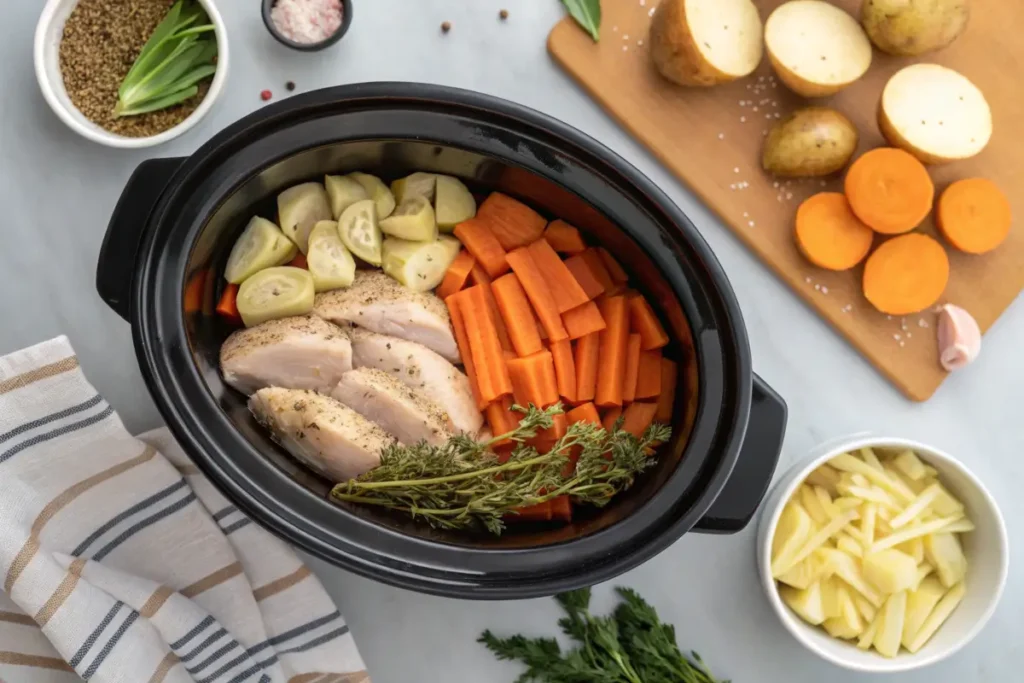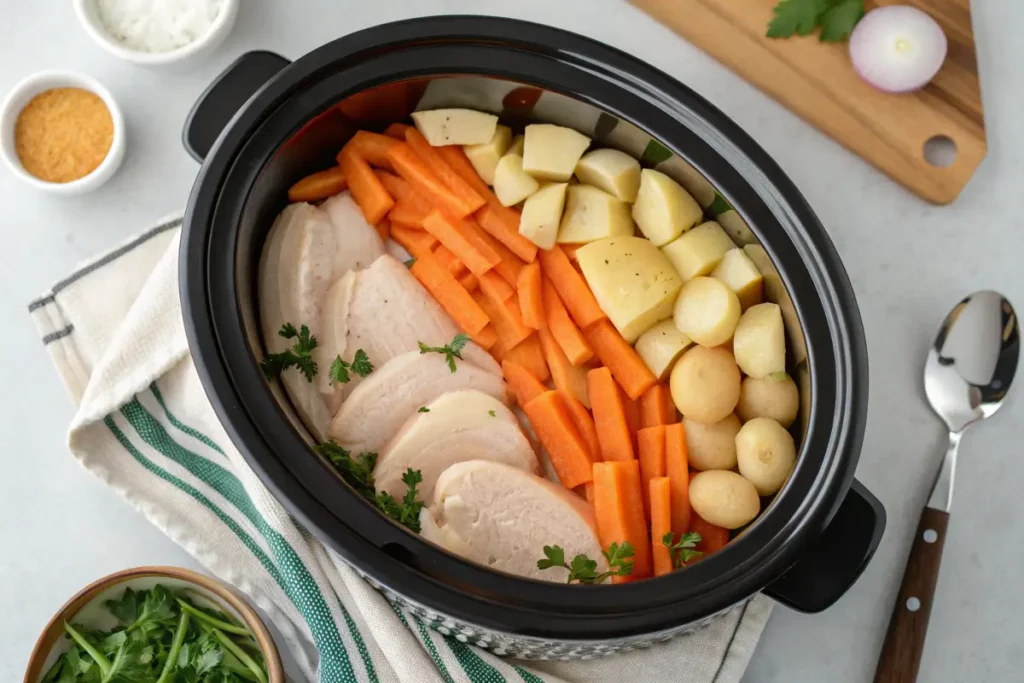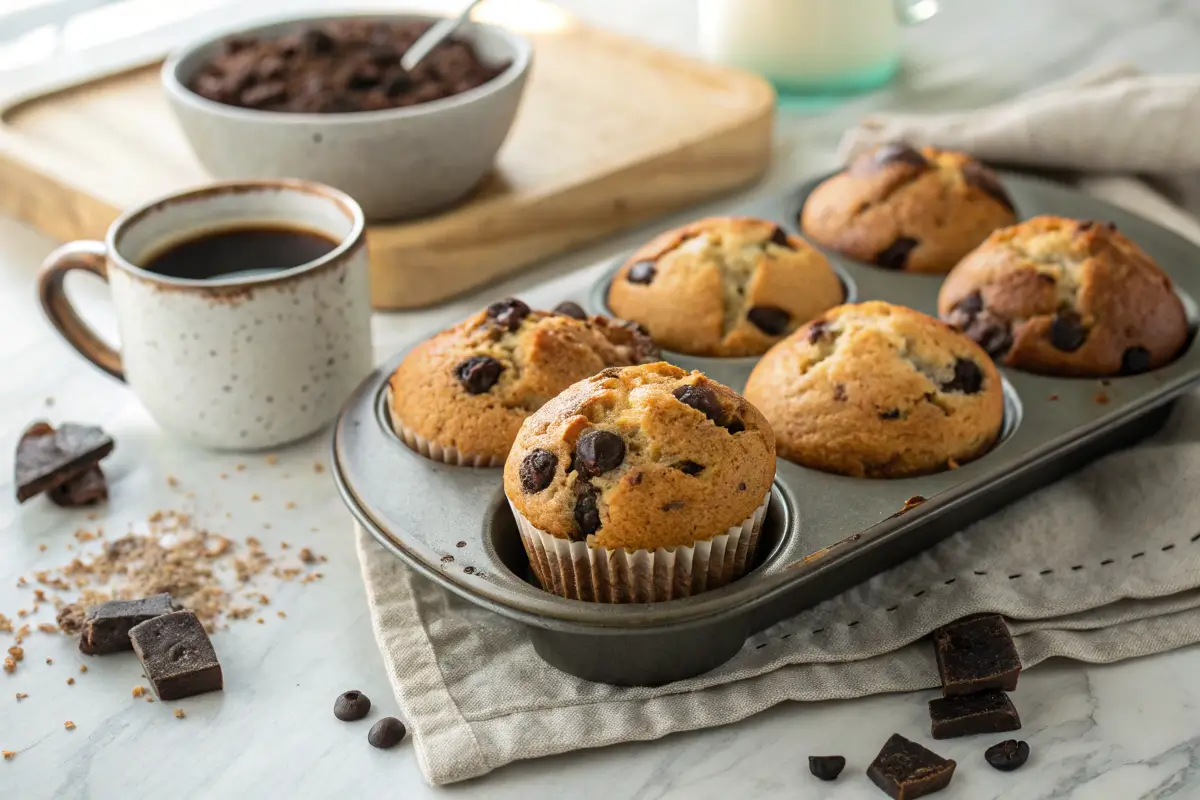Ever stick a few chicken breasts in your slow cooker, only to end up with a tough, strange texture that’s nowhere near appetizing? You’re not alone! Many home cooks wonder why is my chicken rubbery in the crock pot? In this article, we’ll break down the most likely causes of chewy, dry chicken and show you how to fix those pesky chicken texture issues. We’ll dive into everything from cooking temperatures and marinating tips to the best seasoning strategies. Stick around, and you’ll soon discover foolproof ways to achieve that tender, juicy crock pot chicken every time!
Understanding the “Rubbery Chicken” Phenomenon
The Meat Fiber Story
Chicken, like most meats, is made up of muscle fibers, connective tissue, and a bit of fat. When these fibers are exposed to heat for too long or at the wrong temperature, they can seize up and leave your dish with that infamous “chewy chicken” problem. Crock pots, by design, maintain a consistent temperature for extended periods—great for breaking down collagen but potentially troublesome if you’re not paying attention to time and temperature control.
Moreover, collagen breakdown in chicken transforms tough portions into tender bites, yet if you overshoot the sweet spot, you risk creating dryness and an overly firm bite. If you’re aiming for juicy crock pot chicken, you need to walk a fine line between cooking long enough to meld flavors and avoiding overcooked poultry solutions.
Dry vs. Juicy: The Slow Cooking Balance
Slow cooking is often hailed for its moist cooking methods, letting you toss everything in one pot and walk away. However, “low and slow” doesn’t guarantee success if you ignore the finer details. The key is to maintain a proper crock pot cooking temperature and ensure there’s enough liquid to prevent the meat from drying out. Too little liquid can produce a tough texture; too much might dilute your seasonings.
Ultimately, the balance between dry and juicy depends on how the heat, moisture, and time interact with the chicken’s natural structure. With a few tweaks—like checking the safe internal temperature for chicken and ensuring a proper seasoning balance—you’ll be well on your way to preventing that dreaded rubbery texture.
Common Culprits of Chewy or Rubbery Chicken
Overcooking: Time and Temperature Mistakes
Overcooking is one of the biggest culprits when you’re left asking “Why is my chicken rubbery in the crock pot?” Although a slow cooker tip is to set it and forget it, blindly following cook times can be risky. Indeed, leaving your bird swimming in the pot all day might sound convenient, yet it often transforms tender meat into a dry, chewy mess. Moreover, some slow cookers have varying heat levels, which can sneakily push your chicken beyond the safe internal temperature for chicken, causing moisture loss and white meat dryness.
To avoid time and temperature mishaps, try checking the thickest portion of the meat about an hour before the recommended cook time ends. Furthermore, employ a reliable thermometer to ensure your chicken remains in the 165°F sweet spot for safety. Besides, many slow cooker recipes assume you are using thick chicken breasts or bone-in thighs, so adjusting times based on cut type is essential. And remember, size matters—larger pieces of chicken require more time, but too much time can lead to overcooked poultry solutions you’d rather avoid.
Insufficient Liquid or Seasoning
Another reason chicken texture issues pop up is not including sufficient liquid or marinade. After all, moisture is key to soft, succulent meat. Yet, sauce alone might not guarantee success if you trek the “low and slow” path forever. Additionally, using minimal liquid can starve the chicken of the steam it needs for even cooking, which can result in rubbery texture.
Hence, it’s wise to balance liquids and seasonings in the pot. A properly salted or brined piece of chicken retains its natural juices longer. This alignment of time, temperature, and seasoning helps prevent chewy chicken, leaving you with the juicy crock pot chicken you crave. Just like building an outline for a speech, getting each layer right leads to a better result.
The Science of Slow Cooking Chicken Perfectly
Proteins and Collagen Breakdown
To truly conquer “Why is my chicken rubbery in the crock pot?” you’ll want to understand how proteins and collagen behave in a moist environment. When chicken cooks, muscle fibers tighten, while collagen (the tough connective tissue) gradually dissolves into gelatin. Surprisingly, this breakdown doesn’t happen all at once. Instead, collagen melts slowly at lower temperatures, ideally turning tough cuts into melt-in-your-mouth goodness. In fact, this chemical transformation is the reason dark meat often fares better in extended slow cooking—there’s typically more collagen to soften.
Furthermore, using moist cooking methods ensures the meat remains bathed in liquid, allowing the collagen to steadily convert. Meanwhile, adding a dash of vinegar or other acidic ingredients can help because mild acidity supports this tenderizing process. Moreover, a dash of patience pays off: let the collagen fully dissolve without overcooking your chicken. Done right, the result is a chewy chicken remedy that focuses on capturing maximum flavor and texture.
Safe Internal Temperatures and Food Safety
Although the collagen breakdown is vital for tenderness, you still need to manage food safety concerns. According to standard recommendations, chicken must reach an internal temperature of at least 165°F to be considered safe. However, hovering too far above that range for too long can drain away valuable juices, leaving a rubbery texture in its wake. Therefore, keep track of cooking progress using a high-quality meat thermometer.
Likewise, make sure you clean your slow cooker and all utensils properly to avoid cross-contamination. Small steps—such as using separate cutting boards for raw and cooked chicken—go a long way in preventing illnesses. After all, balancing taste, texture, and safety is your best formula for the chewy chicken remedy you’ve been seeking. And, as with outlining a paper for clarity, following these guidelines ensures a well-structured and delicious dish.
Marinating, Brining, and Other Solutions to Prevent Rubbery Chicken
Benefits of Acidic Marinades
Ever wonder if a zingy marinade can help solve chicken texture issues? Indeed, a quick soak in a tangy mixture can transform your poultry from bland to bursting with flavor. Moreover, mild acids, such as lemon juice or vinegar, help break down proteins in the chicken, leading to a more tender texture. Thus, adding a little citrus can act like a chewy chicken remedy, infusing both taste and moisture. However, it’s wise not to overdo it, since highly acidic marinades, when left too long, may toughen the outer layer of your chicken.
Additionally, pairing acids with oil, herbs, and spices can lock in moisture while layering flavors. For instance, a marinade with olive oil, minced garlic, dried oregano, and vinegar can improve white meat dryness while also giving your chicken a savory, herby finish. Then, when you eventually place that poultry in the slow cooker, it’s already primed for maximum juiciness and minimal rubberiness.
Simple Step-by-Step Brining Techniques
Brining is another key step if you’re asking yourself, “Why is my chicken rubbery in the crock pot?” A basic brine includes salt, water, and optional seasonings. The salt causes proteins to expand, giving the chicken a chance to hold onto more water. As a result, when it cooks, it loses less moisture, leaving you with juicy crock pot chicken.
To get started, dissolve salt in cold water, then submerge your chicken for several hours or overnight in the fridge. Once done, rinse off any excess salt, pat the chicken dry, and you’re set. The extra juiciness helps avoid dryness during the low and slow cooking process. It’s that simple!
For more delicious recipes, check out our recipe article on Vitaly Recipes.
Choosing the Best Cuts of Chicken for Crock Pot Success
Bone-In vs. Boneless Chicken
Knowing which chicken cut to use can be a game-changer when navigating crock pot cooking temperature and cook times. Bone-in chicken, for instance, can yield more flavor and natural fats—both help keep meat moist. Likewise, the bone itself helps regulate internal heat, preventing it from skyrocketing. Conversely, boneless pieces cook faster, which can shorten your total prep time. However, you might risk overcooking, since you have less built-in buffer against dryness.
Furthermore, bone-in thighs or bone-in breasts contain more connective tissue—a plus for collagen breakdown. When slow-cooked, this collagen converts into gelatin, lending a richer mouthfeel. Therefore, if you’re craving a comforting, fall-off-the-bone meal, opting for bone-in cuts can offer an easier path to avoiding chewy chicken. On the other hand, boneless breasts can be fantastic if paired with brines, marinades, or a watchful eye on your crock pot’s temperature settings.
Dark Meat vs. White Meat Considerations
Dark meat is often better suited for long cook times because it naturally contains higher fat content and more connective tissue. Thus, thighs and drumsticks more readily hold onto moisture, which lowers the chance of exposing you to that dreaded rubbery texture. Conversely, white meat (like chicken breasts) can dry out swiftly if you leave it in the pot too long or omit enough liquid.
Still, some folks prefer white meat’s leaner texture and familiar taste. If that sounds like you, remember to incorporate brining or marinating. Also, track your cooking time closely to prevent overcooking. By choosing the right cut—and managing moisture levels—you’ll sidestep why is my chicken rubbery in the crock pot? woes and savor a satisfying, tender meal every time.
Cooking Techniques to Avoid Rubbery Texture

Layering Ingredients Properly
Many folks throw everything into the slow cooker at once, but careful layering helps prevent overcooked poultry solutions. First, place heavier items like root veggies or potatoes on the bottom, then rest your chicken on top with a little liquid. Because the bottom of the crock pot can get hotter, you reduce the chicken’s direct exposure to excess heat. Meanwhile, adding veggies above or around the chicken lets them mingle with the juices, enhancing flavor.
Additionally, be mindful of how you arrange other items, such as sauce or canned tomatoes. Pouring these components directly over the top can protect the chicken from drying out. Yet, use caution with sugary sauces because they can burn if left near the pot’s edges for too long. Whenever you face the query, Why is my chicken rubbery in the crock pot? remember that every item’s position can impact how evenly heat and moisture distribute.
Of course, don’t forget to maintain an appropriate crock pot cooking temperature. In some recipes, you can briefly sear chicken before placing it into the slow cooker. This step helps seal in juices and creates a richer exterior color. While not mandatory, searing adds another layer of flavor and texture. All in all, proper layering, strategic searing, and a watchful approach help keep chewy chicken at bay, so you can enjoy consistent, tender results every time.
Using a Meat Thermometer for Precision

A trusty meat thermometer is crucial for ensuring safe internal temperatures and avoiding rubbery bites. Take readings from the thickest part of the chicken, making sure you don’t hit a bone. Because bone temperatures don’t accurately reflect the meat’s internal doneness, you want a direct reading of the chicken itself.
Generally, 165°F is the minimum safe internal temperature. However, you might allow a slightly higher temp if you prefer extra tenderness from collagen breakdown. Keep in mind that too long above 165°F can trigger dryness, especially for white meat. Hence, check early and often, so you don’t wind up with dry, tough, or chewy chicken.
Furthermore, rotating or flipping the chicken mid-cook also promotes even heating, especially if you’re using lean cuts. By combining thermometer checks with strategic flipping, you can nail that perfect tenderness without guesswork. After all, knowledge is power—and in the realm of crock pot cooking, it’s your golden ticket to preventing that dreaded rubbery texture.
Additional Tips and Recipe Ideas for Tender Slow Cooker Chicken
Combining Flavors: Herbs, Spices, and Sauces
When you’re scratching your head asking, Why is my chicken rubbery in the crock pot? the culprit might be the way you season your ingredients.
Indeed, proper flavor balancing does more than just add taste; it can impact texture due to the interaction of spices, herbs, and sauces. Start with salt, pepper, and a mild herb like thyme or oregano, then layer in bolder flavors such as paprika, cumin, or chili flakes. Additionally, don’t forget aromatic veggies like onions and garlic, which add moisture along with taste.
Meanwhile, try adding a splash of chicken stock or white wine to nourish the meat as it cooks. And if you crave a sweeter profile, toss in a spoonful of honey or brown sugar. The goal is to craft a flavorful environment that helps the chicken stay moist. Liquid, after all, is a friend to slow-cooked meat.
Low and Slow vs. High and Quick Cooking Methods
Though the slow cooker is designed for gradual cooking, many devices include a “high” setting. Indeed, using a higher setting can reduce total cook time, but it may also raise the risk of rubbery results if left unchecked. Conversely, “low and slow” cooking is ideal for breaking down collagen, especially in dark meat, to deliver a tender mouthfeel. However, if you already used a marinade or brine, you might get away with a slightly higher temperature.
Therefore, experiment carefully. If you opt for a high setting, check your chicken frequently with a thermometer. If you lean toward low and slow, confirm sufficient liquid to keep dryness at bay. Above all, remember that timing is everything. Combine thoughtful flavor layers with the right level of heat, and you’ll handle chewy chicken remedy worries like a pro. By striking this balance, your next slow cooker meal can emerge juicy, tender, and fully satisfying.
Frequently Asked Questions: Why Is My Chicken Rubbery in the Crock Pot?
“Is It Safe to Cook Frozen Chicken in a Slow Cooker?”
Safety is a top concern, especially when dealing with poultry. Indeed, some cooks wonder if cooking frozen chicken in a slow cooker is acceptable. Technically, it is possible, but experts advise against it because frozen meat stays in the “danger zone” temperature range (40°F–140°F) much longer. This longer exposure can foster bacterial growth, which is the opposite of what you want when tackling why is my chicken rubbery in the crock pot?
Furthermore, placing frozen chicken directly in the crock pot forces the cooker to spend extra time thawing and heating the meat to a safe internal temperature for chicken. During this extended period, your chicken may lose more moisture than normal. Consequently, you could wind up confronting a dreaded rubbery texture. Therefore, it’s safer and more effective to thaw the chicken thoroughly in the refrigerator before cooking. Doing so can help ensure both food safety and more tender results.
“How Do I Fix Rubbery Chicken Mid-Cooking?”
Despite your best efforts, you might notice your chicken starting to feel rubbery before the end of the cooking time. First, check the liquid level. If it’s too low, add a bit of chicken broth or sauce to improve moisture. Next, reduce the heat setting if possible, which gives the collagen more time to break down without scorching the exterior. Then, give your dish a gentle stir to redistribute flavors and heat.
Additionally, consider a quick fix like shredding the chicken. Shredded chicken naturally mixes with any sauce, helping to mask slight rubberiness. Above all, keep a meat thermometer on hand. If the chicken is close to being fully cooked, easing off on the heat and adding more liquid can still save the day. By acting fast, you might salvage dinner and end up with juicy crock pot chicken instead of a chewy disappointment.
Conclusion
In sum, answering Why is my chicken rubbery in the crock pot? takes a blend of knowledge and careful steps. Whether you marinate, brine, or use the proper cut, paying attention to temperature, time, and seasoning can change everything. Moreover, strategic layering, using a thermometer, and adding enough liquid all help produce tender, flavorful chicken. By staying alert to smaller details—like rotating the chicken or checking moisture levels—you’ll easily avoid that rubbery texture. With these tips, you’ll enjoy delicious slow-cooked meals that highlight chicken’s best qualities, ensuring you never endure another chewy bite again. Bon appétit!
- Maggiano’s Recipes Italian Classics – “Recreate beloved Italian favorites with our Maggiano’s Recipes Italian Classics.”
- Feta Vegetable Bake Recipe – “Make a nutritious dinner tonight with our savory Feta Vegetable Bake Recipe.”
- The Secret to Juicy Meatloaf – “No more dry dishes—discover the secret to juicy meatloaf here.”
- Basic Meatloaf Formula – “Find a foolproof approach with our basic meatloaf formula for perfect results.”
- Meatloaf Recipe Lipton Onion Soup – “Pack extra flavor into your main course with our Meatloaf Recipe Lipton Onion Soup.”
- Should You Cook Onions Before Adding to Meatloaf? – “Enhance your dish by learning whether you should cook onions before adding to meatloaf.”
- What Not to Put in Meatloaf – “Avoid common mistakes with our simple guide on what not to put in meatloaf.”
- Crock Pot Chicken Piccata – “Enjoy fresh Mediterranean flavors with this easy Crock Pot Chicken Piccata.”
- Is It Okay to Put Raw Chicken in a Crock Pot? – “Find answers to food safety questions and learn if it’s okay to put raw chicken in a crock pot.”
- Good Side Chicken Piccata – “Compliment your main course with a good side chicken piccata that balances any meal.”






